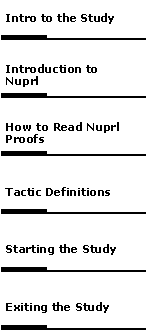|
This proof proves the theorem
 a,b: a,b: . .  c: c: . (a -- b) -- c = a -- (b + c) . (a -- b) -- c = a -- (b + c)
The following definitions are used in this proof:
- imax (integer maximum)
- imax(a;b) == if a
 z b then b else a fi z b then b else a fi
- ndiff
- a -- b == imax(a - b;0)
The following lemmas are used in this proof:
- add_com
 a,b: a,b: . a + b = b + a . a + b = b + a
- imax_add_r
 a,b,c: a,b,c: . imax(a;b) + c = imax(a + c;b + c) . imax(a;b) + c = imax(a + c;b + c)
- imax_assoc
 a,b,c: a,b,c: . imax(a;imax(b;c)) = imax(imax(a;b);c) . imax(a;imax(b;c)) = imax(imax(a;b);c)
Please do the following and record your answers:
- Translate this proof into English.
- Was there any part of this proof that you found difficult to translate? If
so, why?
- Do you think that this theorem was proved in a natural or intuitive
manner or not? If so, why?
|
|



